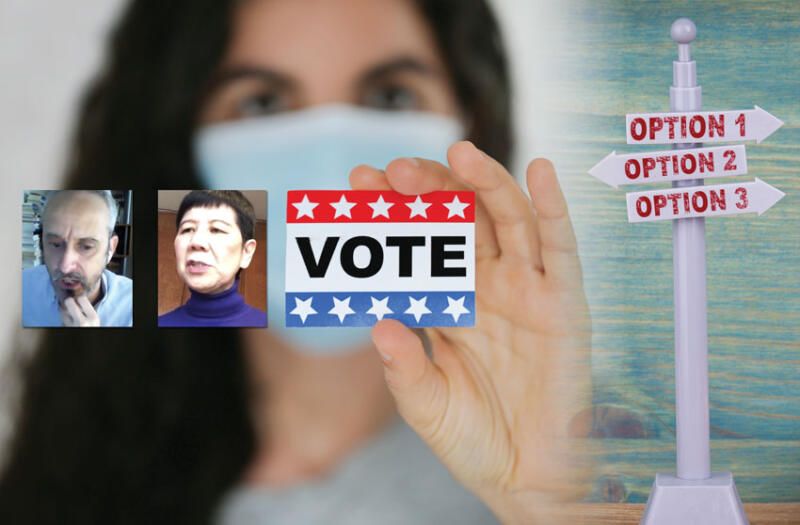Jury Still Out on San Francisco’s Ranked Choice Voting
By Sunita Sohrabji/EMS Contributing Editor
Ranked choice voting — an electoral reform passed by San Francisco voters in 2002 — aims to encourage more diverse participation by allowing voters to pick more than one candidate for a contested seat. But the jury is still out on its impact, and some data suggest it may actually deter people of color and immigrants from voting, according to a panel of experts and advocates.
San Francisco is one of 13 U.S. cities to use ranked choice voting, along with the East Bay cities of Berkeley, Oakland, and San Leandro, as well as the state of Maine. Many countries around the world — including Scotland, Northern Ireland, Australia, and New Zealand —also use ranked choice voting, an alternative to the more traditional system of plurality voting, in which a winner takes all.
Jason McDaniel, Associate Professor of Political Science at San Francisco State University, used the example of the hotly-contested 2018 San Francisco special election mayoral race to illustrate how the system works. In that race, eight candidates vied for the seat left vacant after the unexpected death of Mayor Ed Lee.
Voters in the election were allowed to choose up to eight candidates in their order of preference. Some chose just one, while others ranked all eight, explained McDaniel.
In the first round of tabulation, as no candidate emerged a clear winner with over 50 percent of the vote, London Breed took the lead with more than 35 percent, with former California state Assemblyman Mark Leno, and former Board of Supervisors Jane Kim and Angela Alioto close at hand, and five other contenders with votes collectively under 20,000. Antoine Rogers was eliminated in the second round; his three votes were reallocated to his supporters’ second choice. Michelle Bravo was eliminated in the third round and her votes went to her supporters’ second choice.
The battle went on for a total of eight rounds of tabulation: veteran politician Alioto was eliminated in Round 7. As her votes were re-distributed, Leno emerged in second place with about 2,000 votes over Kim, with Breed still leading with 102, 767 votes. Kim was eliminated in the 8th round; as her votes were re-distributed in the 9th round, Leno conceded to Breed, who managed to get 50.5 percent of the vote. Leno received 49.5 percent of the vote in the final round: less than 2,000 votes separated the candidates.
Proponents of ranked choice voting say the system eliminates costly and time-consuming run-off elections. It also allows voters to feel as though their vote is not wasted if they pick an underdog candidate as their first choice. Supporters also say it allows encourages first-time candidates from under-represented communities to enter races, knowing they will get some support.
But McDaniel believes the system could lead to disparities in voting. “It advantages higher education voters and older voters who are used to the process.”
“The complexity is a barrier; not an insurmountable barrier, but a barrier nonetheless,” he said.
McDaniel added h that San Francisco’s Department of Elections has done a really good job in educating voters about the process and this year designed an easier ballot form on which to record candidate preferences. It will result in far fewer errors, he predicted.
Anni Chung, president and CEO of Self Help for the Elderly, a chain of senior centers around San Francisco, said ranked choice voting is a bit difficult for limited English speakers. “Ranked choice voting has always been a mystery to me, even now after all these years,”she said with a chuckle.
Chung also credited the San Francisco Department of Elections for doing a “phenomenal job of educating voters with limited English proficiency.” Before every major election, bilingual speakers come out to each branch of her 14 senior centers to educate voters about ranked choice voting.
Asian American seniors have a very high regard for what’s right and what’s wrong, often deterring them from voting because they don’t want to vote incorrectly, said Chung.
“So we have to continuously tell them ‘you have to vote with your heart and there’s no right or wrong.’ We want you to express how you stand on certain issues and which candidate represents your value,” she said.
Ballot measures, written in complex language, also pose a deterrent, said Chung, who urges her seniors to vote on the candidates and issues they care about, and forgo the rest. Ballots with some responses left blank are still counted.
Chung said that, in recent years, she has seen a dramatic upswing in the number of Chinese seniors who are registered to vote.
Eve Pena, assistant outreach director with the San Francisco Department of Elections, said ranked choice voting allows voters to believe that every candidate matters. Latinx community leaders spearheading get out the vote initiatives are telling voters: “Here is your opportunity to rank the candidates in your order of preference because they’re all important,” she said, adding: “that’s a great point because some people just want to choose for the affinity aspect someone that they feel close to, and then give an additional ranking to someone who’s more popular.”
Pena said during the briefing that ballots with mistakes on them can still be accepted, if the tabulator can determine the “voter’s intent.”
“If you cross out the candidate that you don’t want and you indicate no, ‘this is my preference,’ and if we can see that you made distinctive marks letting us know who you are choosing, we can accept that and validate it for you,” said Pena, noting that “human eyes” do the processing.
Voters who still want reassurance can request a replacement ballot to be sent by mail.


